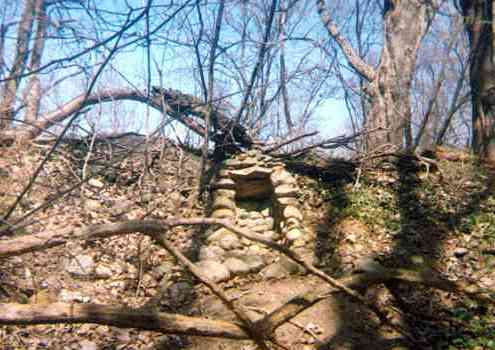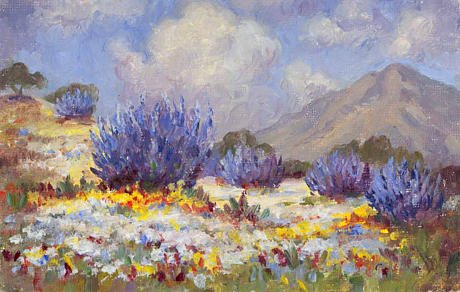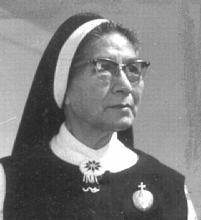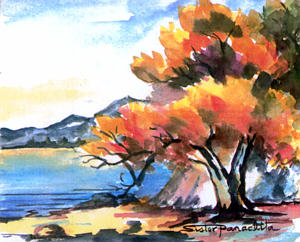
A Cave of Candles / by Dorothy V. Corson

Chapter 8

The Ghost of a Grotto in the Glen
Shortly after my meeting with Mary Grix, I found myself becoming interested in the history of the Sisters of the Holy Cross who were closely associated with Notre Dame from the very beginning. I looked forward to learning what I could from my Sister friends on my next visit to St. Mary's Convent, never realizing, I would be aimed in that direction sooner than I expected.
I was talking to Father Boehm, on my usual alternate Friday visit to Holy Cross House on campus. He is in his early eighties and has lived there since his retirement after 30 years as Chaplain of St. Mary's Convent. I met him years before while visiting the Sisters at the convent. I had been sharing with him the progress of my ongoing research of the building of the Notre Dame Grotto. I happened to mention Father Maguire's comment in his letter, that the Grotto Sorin constructed might have been built at St. Mary's. I told him I had called the Convent Archives, but was informed there was no Grotto on the St. Mary's grounds and never had been!
To which, Father Boehm replied, "Oh but there was!" When I inquired how he knew about it, he said he had stumbled over the remains of it himself many years before. "It was so overgrown," he said, "you wouldn't have known it was there. It is probably all overgrown again, by now, but you might still be able to find evidence of it."
All of this prompted a charming story of how he had stumbled "head first into it" in the wooded glen between the Church of Loretto and the St. Joseph River which borders St. Mary's property.
He explained that in the 1950s the number of Sisters he ministered to was beginning to dwindle with fewer new Sisters coming into the order. To fill his time, he said, he used to bird watch in the glen behind the rectory.
One day while doing so he accidentally came upon the ruins of an old Grotto. He said it was overgrown and almost completely hidden by fallen trees. Brush and ground covers had nearly covered the floor of stones. The sides of a rising incline formed the walls of the Grotto and its niche was missing its statue. He said he spent many an afternoon afterward removing the debris and weeds covering it. One day he said he was attacked by a nest of bees and made a hasty retreat to the rectory. The alcohol he put on the bites he said, "was like dew from heaven."
Probably more than 35 years had passed since he had uncovered the Grotto. I wondered if I might still be able to locate what was left of it. Father Boehm willingly made me a map to help me find it. He had not been away from Holy Cross House, other than for doctor appointments, since he'd arrived there, so the prospects of him pointing it out to me were slim. I was going to be alone in my search.
Fortunately, my husband accompanied me not wanting me to go down into the glen alone as it was overgrown and in many spots unwalkable. One afternoon, with Father Boehm's map in hand, we tramped the wooded trails looking for the natural rise he had described between the bluff and the river. It was early spring and the weather was nippy. Both of us were chilled. We decided not to go off the beaten trails until better weather. However, before leaving, I spotted what I thought might be the rise he referred to some distance away. I decided to check with him again and wait for better weather before continuing my search.
Two weeks later, during my regular visit to Holy Cross House, I asked Father Boehm if he could pinpoint it a bit closer for me. Better yet, I said, not expecting an affirmative answer, would you like to come along with me and my husband and point us in the right direction from the bluff above the glen? It was a balmy spring day. Surprised and pleased, he agreed, raising eyebrows at the nursing station as we left. He had not been back to St. Mary's in seven years.
Upon our arrival, he brushed aside my admonitions that he not attempt the steep road to the floor of the glen, and said he wouldn't have any trouble. My husband fashioned a staff from a fallen limb for him and he slowly descended the hill with us. At the bottom, I again asked him to wait and I would explore the direction he pointed out. "No," he said, "I can make it." The three of us followed the rise in the ground bordered by an avenue of huge trees marching their way to the river's edge.
The closer we got the more likely it became until the top of the niche appeared, barely visible, over the top of the rise. The two of them stayed above while I worked my way down to the floor of the meadow directly facing the empty niche. A huge limb crisscrossed the front of the Grotto area narrowly missing the stone niche, the only part still visible and intact. Brush and branches and overgrown ground cover along with sand washed down from the bank almost obliterated the scene. Yet, with a little imagination and a brushing away of weeds and dirt one could see that a very presentable facsimile of a Grotto had once graced the meadow it had been placed in.
The blue blossoms of myrtle periwinkle were opening, flooding the greenery with Our Lady's blue, and beside the niche itself was a blossoming trillium as if to herald our long awaited arrival. While they waited, I took photographs to document my find and gloried in the accomplishment of finding something that never was, or at least had been long forgotten.
I was sure that Father Sorin would not have had anything to do with this Grotto as he was known for doing things on a grand scale. Sisters had definitely built this one. The stones appeared to be no larger than could have been carried from the riverbank by two Sisters. Father Sorin's Grotto, if he had built one at St. Mary's, had not been this one. Nonetheless, it intrigued me, and I decided because of Sorin's close association with St. Mary's to take time out and pursue its origin before continuing with my original Notre Dame Grotto research.
With my husband accompanying me, we made one more trip to the Grotto in the glen to take additional photographs on a sunnier day. Mission accomplished we headed up the hill to the top of the bluff. "What's that" my husband said, pointing to a small rock protruding from the rubble covered bank of dirt sloping away from the side of the narrow lane. Being a rock collector from way back, I glanced in the direction he was pointing, leaned over and stretched to reach it, pulling it from the dirt bank. It was about the size of my fist, smoky black and mostly covered with dirt, but the sunlight caught a little glitter in it. One side was smooth and flat, it looked like it would made a good paperweight. Curious, I carried it to the car planning to wash it and look at it more closely later.
When we returned home, I placed it in a pan of soapy water and left it to soak. About to retire for the night, I hurriedly patted it with paper toweling and left it to dry overnight. The next morning when I held it under a lamp, it was a mass of glitter. Tiny sparks of light gleamed every way you turned it. I was delighted, and still am, whenever I look at it. Most especially, because black stones in ages past have had very special spiritual significance. To me, it has become a special remembrance, and a little reward for my efforts to locate the Grotto in the Glen.

Time Out I thought . . .
Having learned as much as I thought I could about the Grotto in the Glen, I decided to take a little more time while I was at St. Mary's -- before returning to my Notre Dame research -- to write a long delayed story. One I had planned to document a number of years before, a short story about Sister Paraclita,(70) a Shoshone Banneck Indian nun, born in Blackfoot, Idaho. The only one in the Sisters of the Holy Cross order. I planned to call it, "The Mystery of Sister Paraclita's Album."
Being 1992, the year of Native American Studies, it seemed the timing was right. Knowing it was now or never, I began at once to see what material I could gather about her in the convent archives never suspecting that in doing so my path would be crossed with someone who could give me even more information about the Grotto in the Glen.
While in Bertrand Hall gathering data about her from the archives, I happened to mention the Grotto in the glen to a Sister Raymunda who was copying some of her archival papers for me. She completely surprised me with, "Oh yes, I remember the Grotto in the Glen. It was completed just before I entered the order, probably, in about 1937 or so." She told me she wasn't there when it was built but she knew a Sister who was. She said she was living at the convent infirmary and asked me if I wanted to visit her. Astonished at my good luck, I told her I'd appreciate it very much. Promising I'd return when the pictures I'd taken of the Grotto were developed, I left elated to find my first clue toward solving the mystery of yet another Grotto -- this one in the glen on the St. Mary's grounds.
My next regular visit to the convent found me in Sister Miriam Kathryn's room asking my usual Grotto questions, pleased to find her responsive and interested in my quest for information. She was able to confirm the approximate 1937 date of the Grotto for me and explained the original story behind its beginnings. She has since become another dear and loving Sister friend who has been following my Grotto research with avid interest.
She told me building the Grotto in the glen was the idea of her Mistress of Novices, a project that was begun and completed by them in their recreation time. Thirty to forty novices took turns working on the Grotto. Half worked at the laundry and half on the Grotto. The Sisters gathered the stones, as large as they could carry, from the riverbanks where there had once been a stone retaining wall, now all but washed away by the strong current of the St. Joseph River. Two Sisters would stand on the small bluff and pass the stones to the Sisters below who then put them in place on the incline walls of the Grotto.
One day she said she was working below the Grotto, positioning the stones passed to her, when a stone fell on her accidentally and her back was badly injured. So much so, that she was unable to navigate the steep hill to the Grotto site and never saw it again. As near as she knew, no pictures were ever taken of it, or if they were, would now be lost. Despite her hurtful experience, she said she would love to see the Grotto uncovered and used again as it was for a brief period of time when the Sisters regularly used the glen for recreational purposes.
However, as time went by, it became more and more isolated, not a good place for the Sisters to go alone or with companions, and the mosquitoes were rampant. Eventually, as the college grew, security must have become a problem and it became off limits for any kind of recreational activities. The statue disappeared from the niche and gradually with the passage of time, weather and erosion, nature had reclaimed its wilderness. The Grotto in the glen, where violets, myrtle and wild flowers bloom in profusion, is visited of late mainly by chipmunks, squirrels and ground hogs. The cheerful voices and song of the Sisters now only echoing memories of the past. Even I could feel it there in the silence, the day I first visited the Grotto in the Glen.
And so back to the drawing board. For sure, Father Sorin's Grotto could not have been the one I found in the glen. Obviously, more research needed to be done before I would be able to prove the whereabouts of Sorin's Grotto, if it ever existed. A sister friend's encouraging comment along the way reverberated in my thoughts: "If we begin the web, He'll provide the thread . . . ."
Before leaving St. Mary's to return to my research at Notre Dame, I decided to take Sister Paraclita's album -- the basis of my story about the Indian Sister -- to the convent parlor so any interested Sisters could take one last look at it before I returned it to its owner. In doing so, I received more thread for the web of circumstances my research was weaving. This time some additional information about the Notre Dame Grotto I hadn't known before. I met Sister Marilyn who was visiting briefly during the summer before returning to her convent, St. Catherine by the Sea, in Ventura, CA. By chance, she had heard the announcement of the viewing over the intercom. She knew Sister Paraclita and came to see what this album of her drawings and paintings was all about.

We had a lovely chat about Sister Paraclita and the research I'd done on her story. All of which led to my telling her of the research I was also doing on the origins of the Notre Dame Grotto. Having found much of my Grotto information had come from unexpected sources, it had become a habit to mention it to anyone new who crossed my path. "Of yes," she said, "and did you know about the two black stones from Lourdes that are also there." This was news to me and something I learned later some knew about, or had heard of, and some had not, though they'd been familiar with the Grotto for many years. Apparently, it was something passed on from person to person, whenever someone viewing it noticed the stones being touched or kissed by others, and inquired about it.
I found the same thing happening to me when later I made a special trip to the Grotto to locate these two stones myself. Someone seeing me tracing them with my fingers asked the same curious question. "Is there something special about those stones?" And so, I myself, became a part of passing on to someone else more lore of the Notre Dame Grotto.
Only in my case, thanks to this newest information from Sister Marilyn, my curiosity was again piqued. Who had put them there and when? One very small, a two inch fragment of stone appeared to have been there since it was built. The other was black the size of a Hershey chocolate bar. The larger one looked as if it had been quickly patched in, the cement still much lighter than the rest of the mortar.
